AMERICAN SHAD Q&A
with Paul MacInnis & Chad Helenthal
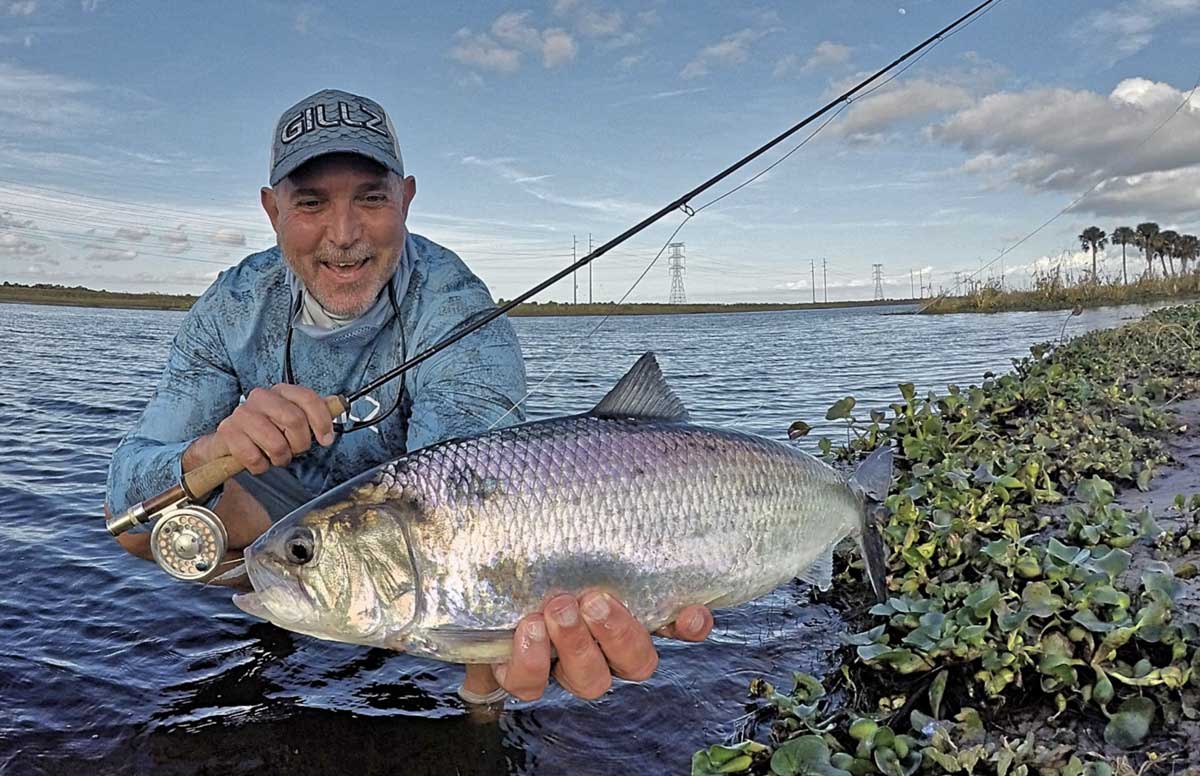
Paul MacInnis digs into American Shad fishing with Chad Helenthal.
It’s Shad Time!
Every year nature serves up a Christmas gift for central Florida anglers in the form of anadromous ocean fish that migrate up the St Johns River to spawn. Fishing for American shad and their smaller cousin, the hickory shad, is unlike any other fishery we have in Central Florida. It’s a mixture of adventure, exploration, gorgeous scenery, great weather, camaraderie and just a whole lot of fun. For advice on how to target shad on the St Johns River, Spacefish Report talked to central Florida shad fishing expert, Chad Helenthal, administrator of shadonthefly.com and Facebook group Shad on the Fly.
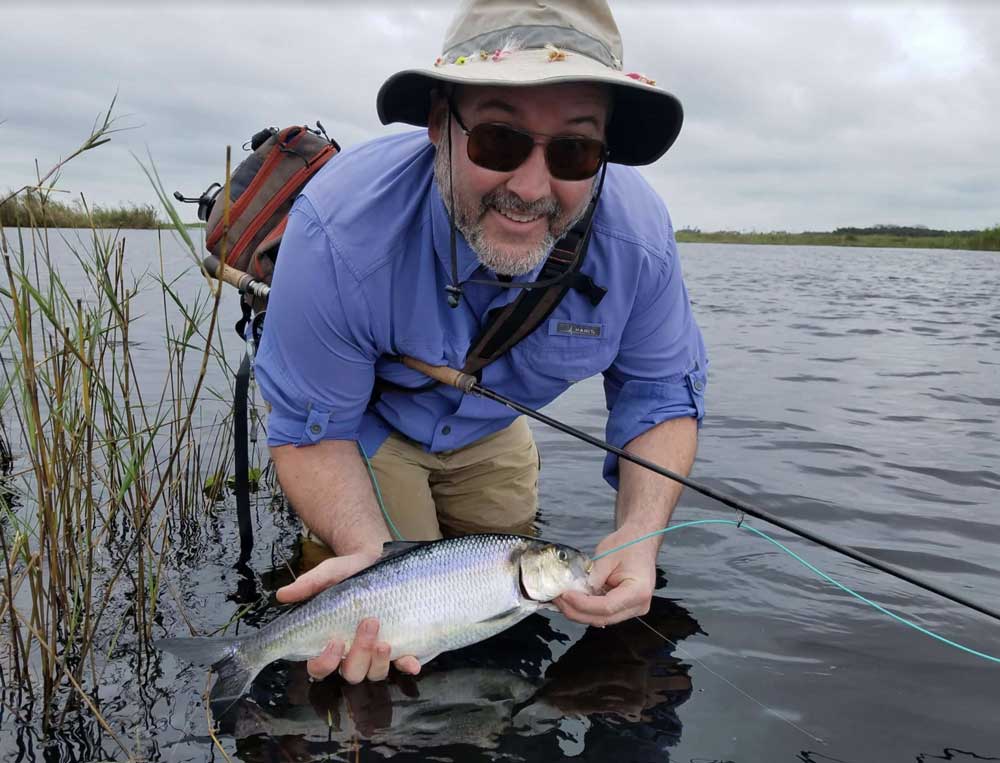
Chad Helenthal with an american shad – photo credit: Chad Helenthal
When are shad in the St Johns?
Helenthal: Shad generally start to show up in the Middle Basin of the St. Johns River in early December and continue to migrate south (upstream) in waves throughout the season. Most years, shad can be caught in the Middle and Upper Basins or tributaries like the Econlockhatchee River until sometime in March. It depends on the year, water levels, and temperatures, but fish have actually been spotted as early as late October and as late as early May.
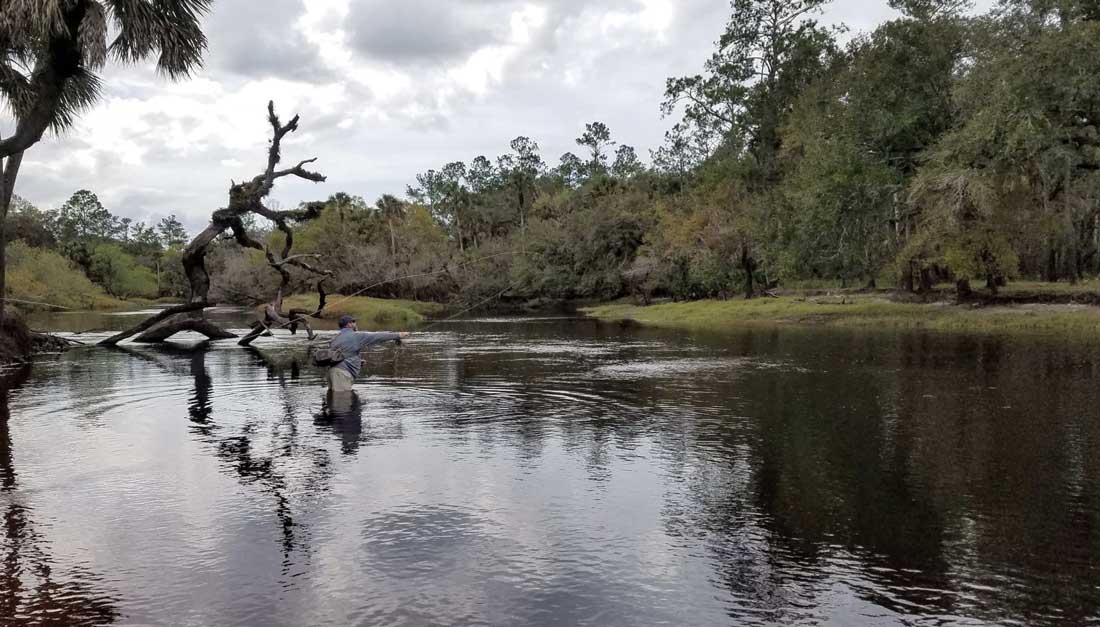
Photo Credit: Chad Helenthal
When is the peak of the shad season?
Helenthal: I would say generally Mid-January through Mid-February, but each year is a little different.
What areas on the St Johns are popular for shad fishing?
Helenthal: Basically the Middle and Upper Basin sections of the river are prime shad fishing areas. On the lower part of the Middle Basin, most of the shad fishing happens in the section of river south of Lake Monroe and north of Lake Harney (Cameron Wight Park, Mullet Lake Park and Lemon Bluff.) This section of river is deeper and wider than upstream, and folks tend to slowly troll small lures behind the boat on several poles until they locate fish, then drop an anchor and work the area thoroughly. Where there is one shad, there are generally many (as they travel in loose schools) and you will likely catch several fish using this technique before they have moved through, then rinse and repeat. Fly fishing is possible in this section of river, but generally requires heavy flies, full sink lines, sink tips, and/ or two handed rods with heavy tips to get the fly down to the fish.
On the upper part of the Middle Basin, most of the shad fishing happens south of Lake Harney and north of S.R. 50 (C.S. Lee Park, Hatbill Park, and the Highway 50 Boat Ramp,) with by far the most well-known and popular area being the section of river between S.R. 46 and Puzzle Lake, which includes the mouth of the Econ. You will find this area to be busy (particularly on weekends,) but generally full of friendly folks chasing shad. When the water is in its banks, the river from Puzzle Lake through Hatbill to S.R. 50, twists and turns in a maze of winding channels with swift current. This entire stretch of river is perfect for shallow draft motorized vessels as well as kayaks and canoes. It is also perfect for fly fishing and conventional light tackle.
On the Upper Basin, most of the shad fishing happens on the section of river south of S.R 50 and north of S.R. 520 (Highway 50 Boat Ramp and Leroy Wright Recreation Area) which includes the Canaveral Marshes Conservation Area and Tosohatchee Wildlife Management Area. Again, when the river is in its banks, this section of river is relatively shallow with plenty of winding turns, deep pools, and runs with accelerating current. While this area is also perfect for fly fishing, conventional light tackle, and shallow draft boats, consideration should be given before deciding to venture out in a kayak or canoe. This section of river is said to have the largest concentration of 10+ foot alligators in the world, plus it tends to have heavy airboat traffic (particularly on the weekends).
On higher water years, shad can even be found south of S.R. 520 and reports of fish at the weir downstream of Lake Washington are not uncommon.
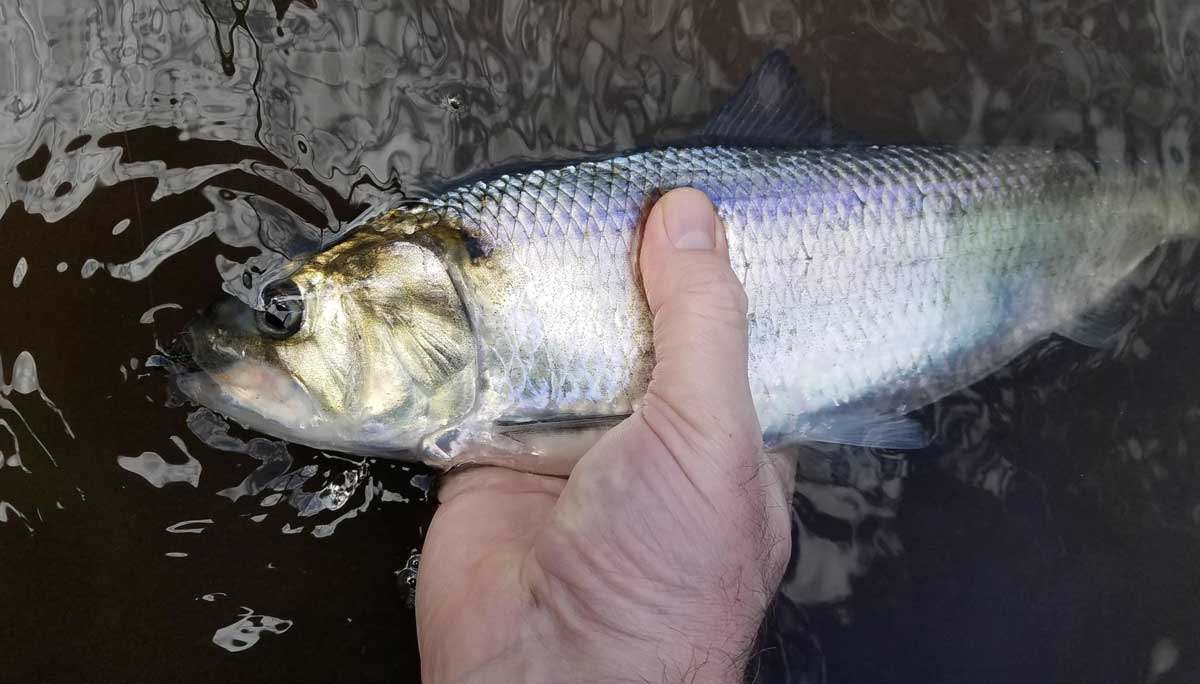
Photo Credit: Chad Helenthal
On any particular day, how should one narrow down where they should try shad fishing?
Helenthal: First off, consider where you are at in the season. If it is early in the shad run, and the fish are just starting to show up, you may want to focus your efforts in the lower part of the Middle Basin. As we move into January and February, you may want to focus on both the lower and upper parts of the Middle Basin. In February you may want to begin focusing south of Puzzle Lake into Hatbill, or further up the Econ. Later in the season you may want to begin focusing on the Upper Basin south of S.R. 50 and so on.
After considering where you are in the season, you should also consider conditions and water levels. If there has been some significant rain in Central Florida, you may see the water level jump a foot or more on the Econlockhatchee, which in turn increases discharge in to the St. Johns which may cause fish to congregate near the mouth of the Econ, or even divert fish further up that river. A bump in water levels and discharge anywhere on the river can get fish moving that may have been congregating in deeper areas, so it is a good idea to check the gauges regularly. A cold snap may shut down the bite and put the fish deep early in the day, but as the water warms up in the shallows, you may find them there, literally right up against the bank. If the water levels are low, you may want to seek out deep pools on the outside of a sharp turn.
Once on the river, how do you find the shad?
Helenthal:After considering conditions, you should seek out areas with good current and nice firm, clean bottom. Shad seek out those areas as they are broadcast spawners, and they tend not to congregate in slow moving water with mucky or silty bottom. Look for areas of the river that split and areas of confluence. Look for bends and fish the heads and tails of those pools. Deeper pools can have fish that are resting outside of the current. Pay attention to seams and eddies as they are great places to focus. Look for noticeable changes in current speed, water depth, or width of the river.
Also, keep a look out for feeding or spawning fish. When shad are feeding, they will aggressively take flies or lures on top water or just subsurface. Spawning activity is easy to recognize, as you will often see one female being chased by multiple males just subsurface, or even with their backs out of the water. When fish are actively spawning (also called washing) they generally will not take a fly or lure, but they will tend to congregate in the area for a while. Mark those spots, as those are places you will want to visit again, and perhaps catch fish that are not actively spawning.
Pay attention to the birds as well. If you see terns darting and diving just above the water, they are generally feeding on grass shrimp or small minnows. If the birds are feeding there, there is a high probability that shad are as well. Large congregations of white pelicans are also suspect.
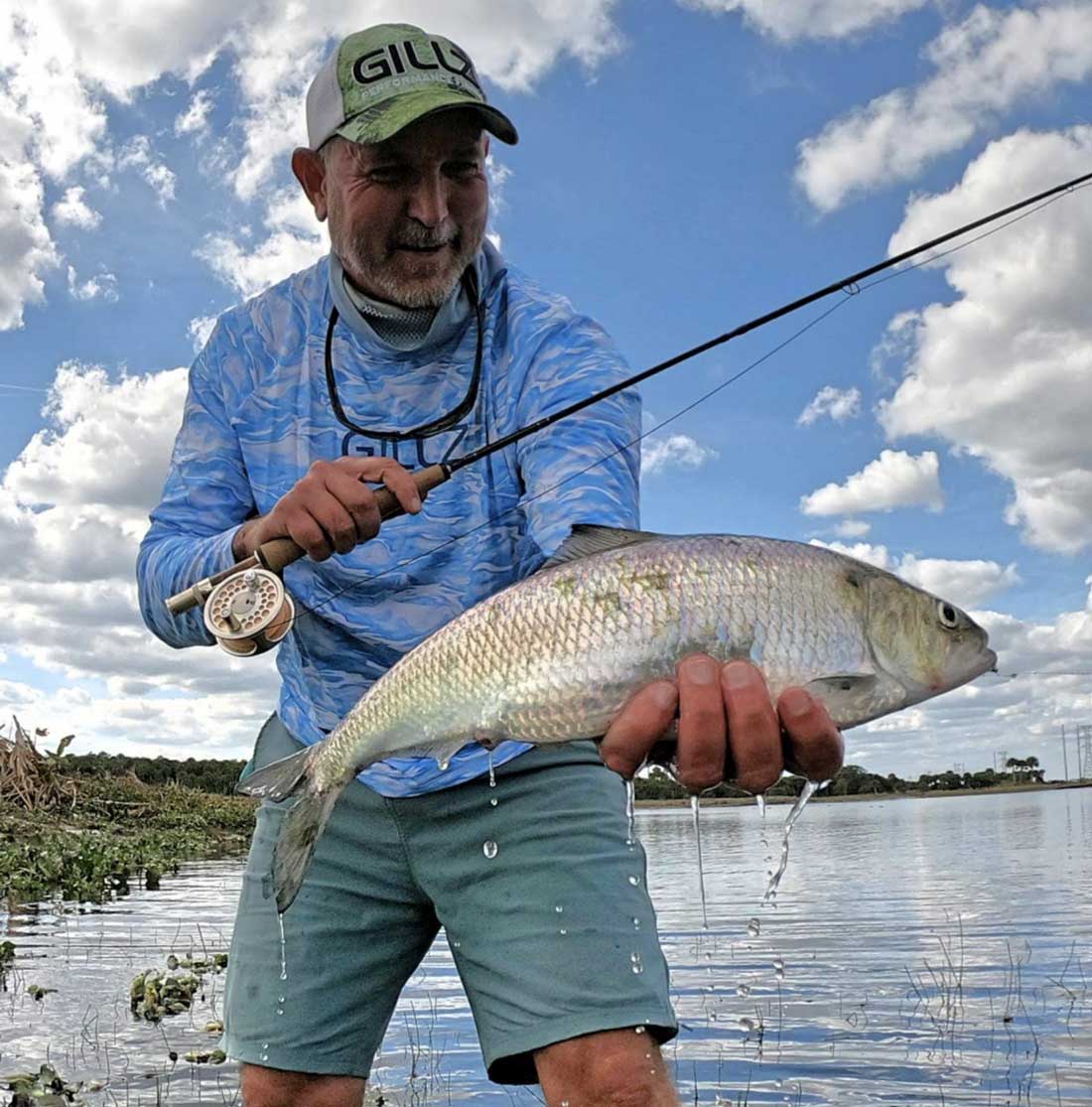
Photo Credit: Paul MacInnis
What conventional tackle do you recommend for shad?
Helenthal: I prefer a 6.5 or 7 foot ultralight rod, 1000 size reel with 6lb test. I like using a braided line with a short 6 foot mono leader attached to the end.
What lures do you recommend for conventional tackle?
Helenthal: I am a fan of shad darts, small crappie jigs, squirrel tail jigs, Road Runners, and 2 inch swim baits. Also, I have found the traditional Shad flutter spoons (i.e. a willow leaf blade with a long Aberdeen hook soldered to it) which have long been used by northern fisherman during their shad runs, to be very successful here as well when fished with 3 or 4 split shot attached to the line 18-24” above the spoon. I have bought quite a few Hardcore Shad Spoons throughout the years.
What fly tackle do you recommend for shad?
Helenthal: For single hand rods, I prefer a 9ft 5wt rod with a matched reel and a floating WF line. To that I tie a 9ft leader with 2x tippet. If the water is high, I may replace the leader with a sinking (6ips) polyleader to help get the fly down in the water column
For two handed rods (my personal preference these days,) I prefer a 10-12 foot switch rod in a 5-6wt with a matched reel. Generally in the early part of the season when the water is high, I use a Skagit line system, as it gives me the flexibility to fish heavy tips to get the fly down in the water column, or quickly switch to a floating tip if the fish are active up top, and everything in between. Later in the season when the water is lower and the fish are spookier, I will switch to a Skandi line system and fish lighter flies with a more delicate presentation.
What flies do you recommend?
Helenthal: I have made instructional videos for dozens of shad flies for my blog, www.shadonthefly.com, and have fished all of them. Every single one of them catches fish. If I had to choose just one fly to fill my boxes with it would undoubtedly be the Kip Tailed Clouser in size 6, tied in a couple different weights (e.g. bead chain and 5/32 hourglass eyes,) and a few different color combinations. That said, I also regularly fish Shad Darts, Shad Comets, Crazy Charlies, and Gotchas.
It is also not a bad idea to have some unweighted flies like the Fry Fly or Gambusia Hair Wing, or even small (size 8-10) floating flies like Gartside Gurglers, Muddler Minnows, or Little Richards handy in case the fish are actively feeding up top or just sub surface.

Photo Credit: Paul MacInnis
What’s your opinion on lure (fly or conventional) color?
Helenthal: I think color is less important than profile. There are days where it seems like shad want brightly colored, flashy flies (or lures,) but I have caught plenty of them on natural tans and greys. Color may help create a better profile by way of contrast in certain conditions, so it does have some value. For instance, I tend to fish flashier flies on overcast days, and use natural colored flies on clear bright days. Also if the water is muddy, I may switch to something bright or even white. All of this said, I still have my favorites! Orange over white, and pink over white make up a lot of what is in my fly box
What is your advice for casting and retrieving lures and flies for shad?
Helenthal: If you do not see fish up top actively feeding or spawning, shad will often be near bottom, so it is important to get the fly or lure down to them. For this reason, quartering upstream is important.
With conventional gear, make your cast slightly upstream, and then keep your bail open long enough to let the lure sink. As your line travels slightly downstream of you, you can close the bail and let the line come taught. You can then continue to let the lure swing until it is hanging straight downstream of you and then start your retrieve, or start retrieving anywhere in between. Starting the retrieve early in the swing pulls the lure up through the water column faster, which allows you to work different areas of the water column. Waiting to start your retrieve until the lure is straight downstream keeps it near bottom longer. I like a slow, steady retrieve with a slight bounce of the rod tip, or a typical retrieve and pause action.
When fly fishing you have a little more control because of your ability to mend the line, but the concept is the same as above. Cast across, up, or downstream and use your mend to allow the fly to sink. You may choose to start your retrieve early in your swing, or forgo the mend to allow the fly to rise through the water faster so you can work the water column thoroughly. Or, you can use your mend to allow the fly to sink and then wait to begin your retrieve until the fly is straight downstream of you. This will keep the fly near the bottom longer. I like to use a strip, strip pause action using short 4-6 inch strips, or a figure eight retrieve. Do not be afraid to mix it up by using long strips, raising the rod tip and then dropping it quickly when the fly is hanging straight downstream, or even quickly retrieving the fly until you figure out what the fish are looking for on that given day.
Shad anglers are generally a friendly lot who are willing to share tips and information. There are several group land based shad trips throughout the season. Novices are welcome and it is a great opportunity to learn the sport from seasoned shad anglers. For advice, fishing reports and information on group trips, visit www.shadonthefly.com and the Facebook group Shad on the Fly.



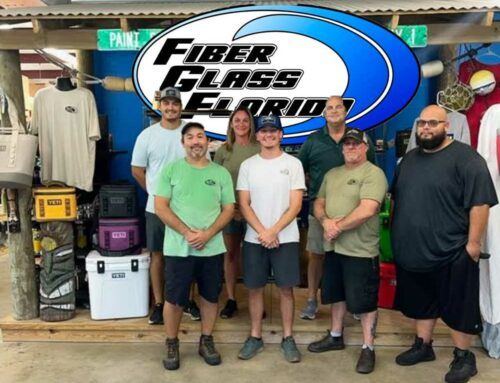
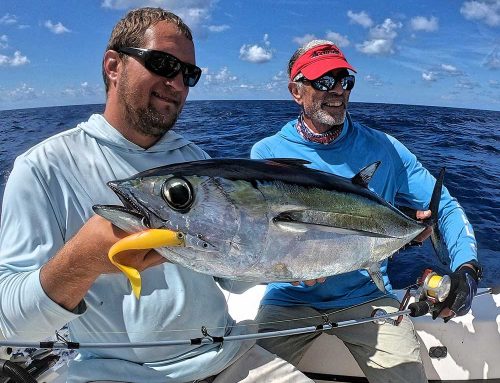
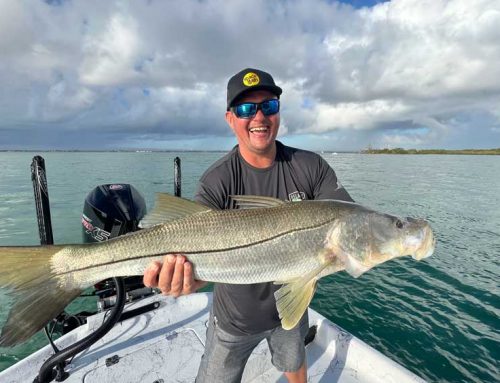


Leave A Comment
You must be logged in to post a comment.